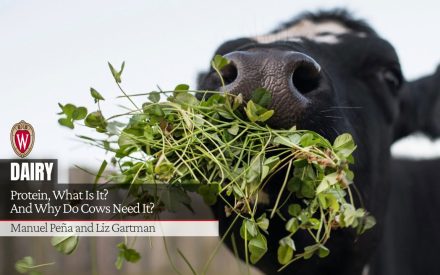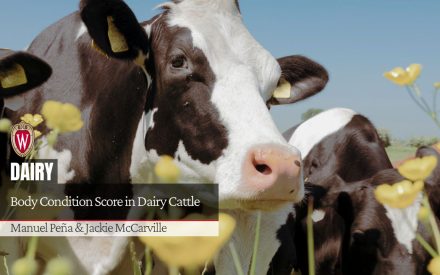During the summer of 2023 Northwest Wisconsin experienced several hail events. Large hail and 60 mph straight line winds came through the Rice Lake area of Barron County on July 20, 2023. On July 24, a hail event also caused damage in central St. Croix County. Adverse weather events, such as drought, wind damage, and hail damage, can create uncertainty for corn growers and livestock producers on potential effects on corn silage yield and nutrient content.
During the summer of 2020, the state of Iowa experienced a derecho, commonly referred to as a “land hurricane.” In a collaborative effort with Iowa State University Extension, fresh samples from affected and non-affected fields were collection for determination of potential differences in corn silage nutrient composition (https://fyi.extension.wisc.edu/dairy/files/2020/10/Down-Corn-Extension.pdf).
Utilizing a similar sampling process, fresh samples from standing corn fields affected from the July 20 and 24 hail events were collected and analyzed for nutrient composition. Whole-plant corn samples were hand harvested from standing fields and chopped on September 6, 8, and 9, 2023. Samples were later analyzed for nutrient composition. Ten samples were collected from fields with hail damage. Nine samples from nearby fields with no or minimal hail damage were collected for comparison.
Fields intended for both silage and grain harvest were sampled. This was intentional, as local corn and livestock producers were inquiring if: 1) damaged fields might test lower for starch, making it a more attractive feed for dairy heifers, dry cows, and beef cattle rations instead of lactating dairy cow rations or harvest as grain, and 2) hail damage would change dry matter content resulting in the need to adjust corn silage harvest timing.
Results
There were no statistical differences in the nutrient composition of hail damaged and control samples, except for water-soluble carbohydrates (WSC; Table 1). Even though WSC is the main substrate for bacteria during silage fermentation, levels were still adequate for hail damaged samples. While dry matter content was not different, it’s worth noting that a wide range of variation was found (SEM 3.53). Dry matter ranged from 27.6 to 44.3 percent for hail damaged samples and 23.4 to 60.0 percent for control samples. Planting date and hybrid was not controlled for which likely added to the extremes in variation. Still, it illustrates the importance of producers doing their own whole-plant moisture checks and making field specific harvest decisions. There was a slight numerical difference in starch content, but it was not significant again due to the wide amount of variation between samples.
Table 1. Effect of hail damage on the forage nutrient composition.
| Item | Control | Hail Damaged | SEM1 | P-values |
| DM, % as fed | 36.8 | 35.8 | 3.53 | 0.73 |
| CP, % DM | 8.05 | 8.18 | 0.21 | 0.66 |
| ADF, % DM | 22.9 | 21.9 | 1.12 | 0.53 |
| aNDFom, % DM | 40.0 | 38.0 | 1.77 | 0.42 |
| Lignin, % aNDFom | 5.37 | 5.62 | 0.44 | 0.61 |
| WSC, % DM | 4.95 | 3.90 | 0.26 | 0.01 |
| Starch, % DM | 34.3 | 37.9 | 2.42 | 0.29 |
| Ash, % DM | 3.69 | 3.77 | 0.21 | 0.79 |
1 Greatest standard error of the mean.
Table 2 shows NDF and starch digestibility. No significant differences in digestibility were observed, although there was a tendency towards control samples having greater starch digestibility, a 1-% unit change is unlikely to be biologically meaningful.
Table 2. NDF and starch digestibility.
| Item | Control | Hail Damaged | SEM1 | P-values |
| NDFD30h, % aNDFom | 61.2 | 60.5 | 1.86 | 0.70 |
| uNDFom240, % DM | 9.90 | 9.92 | 0.69 | 0.98 |
| StarchD, % Starch | 65.2 | 64.1 | 0.74 | 0.06 |
1 Greatest standard error of the mean.
Table 3 shows the predicted energy content for dairy and beef cattle. No significant differences in energy were observed.
Table 3. Predicted energy content.
| Item | Control | Hail Damaged | SEM1 | P-values |
| Nel 3x OARDC | 76.98 | 77.27 | 1.07 | 0.85 |
| TDN, % MLK 2006 Processed | 75.39 | 75.67 | 0.76 | 0.79 |
| MLK 2006 Processed Milk per ton | 3608 | 3662 | 79 | 0.63 |
| TDN, % DM Beef | 69.68 | 69.52 | 1.51 | 0.93 |
| Nem, Mcal/cwt ISU Beef | 75.69 | 75.54 | 1.91 | 0.95 |
| Neg, Mcal/cwt ISU Beef | 48.35 | 48.19 | 1.69 | 0.94 |
1 Greatest standard error of the mean.
Summary
Overall, standing corn silage nutrient composition was similar between hail damaged and control samples near the time of harvest. One of the limitations of this project was that it was not a controlled study. Determining which fields to sample, and where within field to sample, was subjective. In some cases, the area of geographic hail damage was minimal, and a neighboring field could be used as a control. In other cases, it was difficult to find control fields within the same farm. For some fields, damage to outer rows indicated it should be sampled as a hail damaged field, only to find lesser damage further within the field. Northwest Wisconsin was also under drought conditions for most of the 2023 growing season, resulting in multiple stressors that may have impacted these results.
That said, we believe this effort was worthwhile as there is little information available on hail damage effects on standing corn silage nutrient content for making harvest decisions. Establishing a sampling protocol for future events may be beneficial, as differences in the timing of hail damage, severity of damage, and crop growth stage at the time of the damage may produce different results. The goal of this project was to look at harvest time decisions. How the 2023 corn silage crop performs in rations, and if hail damage results in any mold and mycotoxin issues, is yet to be determined.
Acknowledgements
Thank you to Jerry Clark, Extension Regional Crops Educator, for his assistance in processing samples, and to the cooperating producers for their time, knowledge, and field access.

 Protein, What Is It? And Why Do Cows Need It?
Protein, What Is It? And Why Do Cows Need It? ▶️ Watch: Hay There! Let’s Talk Feed Centers and Inventory
▶️ Watch: Hay There! Let’s Talk Feed Centers and Inventory Body Condition Score in Dairy Cattle
Body Condition Score in Dairy Cattle ▶️ Watch: Prácticas de manejo para mejorar la calidad del forraje
▶️ Watch: Prácticas de manejo para mejorar la calidad del forraje


